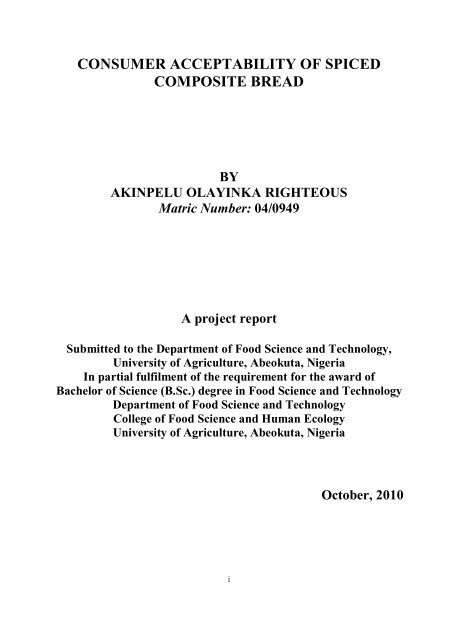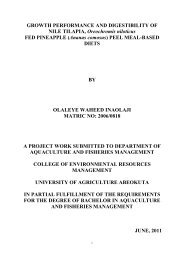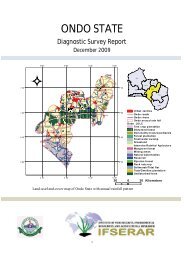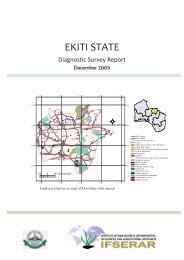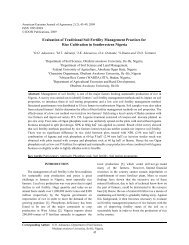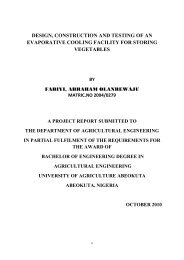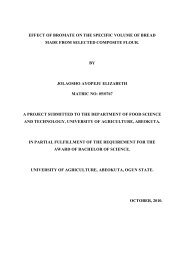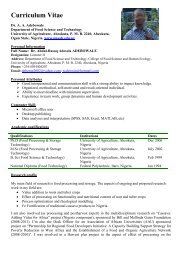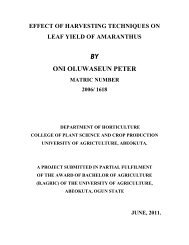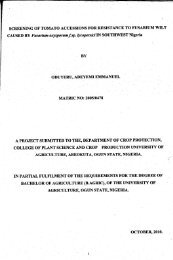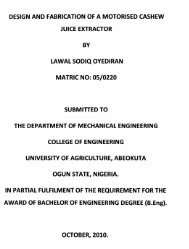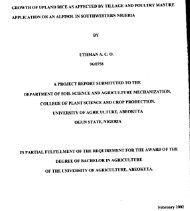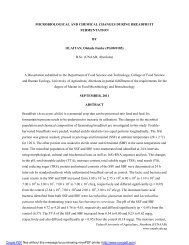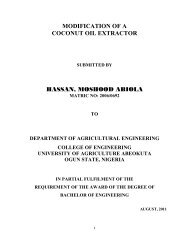consumer acceptability of spiced composite bread - The Federal ...
consumer acceptability of spiced composite bread - The Federal ...
consumer acceptability of spiced composite bread - The Federal ...
You also want an ePaper? Increase the reach of your titles
YUMPU automatically turns print PDFs into web optimized ePapers that Google loves.
CONSUMER ACCEPTABILITY OF SPICED<br />
COMPOSITE BREAD<br />
BY<br />
AKINPELU OLAYINKA RIGHTEOUS<br />
Matric Number: 04/0949<br />
A project report<br />
Submitted to the Department <strong>of</strong> Food Science and Technology,<br />
University <strong>of</strong> Agriculture, Abeokuta, Nigeria<br />
In partial fulfilment <strong>of</strong> the requirement for the award <strong>of</strong><br />
Bachelor <strong>of</strong> Science (B.Sc.) degree in Food Science and Technology<br />
Department <strong>of</strong> Food Science and Technology<br />
College <strong>of</strong> Food Science and Human Ecology<br />
University <strong>of</strong> Agriculture, Abeokuta, Nigeria<br />
October, 2010<br />
i
DEDICATION<br />
This project is dedicated to the Almighty God, the Alpha and Omega <strong>of</strong> my life and to my<br />
dearest parent Mr. and Mrs Ola-Akinpelu.<br />
ii
ACKNOWLEDGEMENT<br />
My pr<strong>of</strong>ound gratitude goes to God Almighty, the Alpha and Omega <strong>of</strong> my life who has been<br />
my sustainer, protector, comforter, the all sufficiency; who has kept me this far.<br />
My sincere gratitude goes to my supervisor, Dr. T.A. Shittu, for his fatherly support, helpful<br />
suggestions, understanding and ever attentive attitude during the execution <strong>of</strong> this research<br />
work and to all lecturers in the department.<br />
Am sincerely grateful to my wonderful family, my parents Mr. and Mrs. Ola-Akinpelu, they<br />
did all they can to see me being successful in life. I pray that you will eat the fruits <strong>of</strong> your<br />
labour. Also to all my siblings, thanks so much.<br />
To my housemate; Akindipe Biodun (Bgreat), Olajide Olawole, Adekunle Isiaka, thanks for<br />
your care, encouragement, patient and love during our stay together. I love you all.<br />
I can’t but appreciate Dania Oluwafemi for his support towards me for the completion <strong>of</strong> my<br />
project.<br />
I also appreciate the support and encouragement <strong>of</strong> my friend both in FST and other<br />
department. Kujore Oluwafemi, Ogunsade Tosin, Aremu Tosin, Aborisade, Emmanuel,<br />
Isinyemi, Peju, Doyin, Deebam, Chuks, Osagie, Tallest, Wunmi, Dipole, Dipo, Freeway, Femi,<br />
Olusesin, FM, Ayodeji, Akinbola, Kemi, Folakemi, Toyin (wonderful HOC),<br />
Finally, to my family, friends, executives and members <strong>of</strong> <strong>The</strong> Redeemed Christian Fellowship<br />
(UNAAB) my prayer for you all is that God in His infinity mercy will continue to guide and<br />
protect you all.<br />
iii
TABLE OF CONTENT<br />
Table <strong>of</strong> content<br />
Page<br />
Title page<br />
i<br />
Certification<br />
ii<br />
Dedication<br />
iii<br />
Acknowledgement<br />
iv<br />
Table <strong>of</strong> content<br />
v - vii<br />
List <strong>of</strong> tables<br />
viii<br />
List <strong>of</strong> figures<br />
ix<br />
Abstract<br />
x<br />
CHAPTER ONE<br />
1.0 Introduction 1<br />
CHAPTER TWO<br />
2.0 Literature review 4<br />
2.1 Wheat 4<br />
2.1.1 Original and distribution <strong>of</strong> wheat 4<br />
2.1.2 Composition <strong>of</strong> wheat grain 5<br />
2.1.3 Wheat milling 6<br />
iv
2.1.4 Nutritional value <strong>of</strong> wheat 7<br />
2.2 Botany and Classification <strong>of</strong> Cassava 9<br />
2.2.1 Processing <strong>of</strong> cassava 9<br />
2.2.2 High quality cassava flour 10<br />
2.3 Spices 12<br />
2.3.1 Nature <strong>of</strong> spices 12<br />
2.3.2 Forms <strong>of</strong> Spices 14<br />
2.4 Ginger 14<br />
2.4.1 Ginger oleoresin 15<br />
2.4.2 Uses 16<br />
2.5 Bread 16<br />
2.5.1 Function <strong>of</strong> <strong>bread</strong> baking ingredient 16<br />
2.5.1.1 Fats or shortenings 16<br />
2.5.1.2 Yeast 17<br />
2.5.3. Sugar 17<br />
2.5.4. Salt 17<br />
2.5.4. Water 17<br />
2.5.5. Bread improvers 18<br />
v
CHAPTER THREE<br />
3.0 Materials and Method. 19<br />
3.1 Raw Materials 19<br />
3.2 Methods 19<br />
3.2.1 Preparation <strong>of</strong> oleoresin from ginger 19<br />
3.2.2 Production <strong>of</strong> <strong>bread</strong> 22<br />
3.2.3 Consumer Survey 25<br />
3.2.4 Data Analysis 25<br />
CHAPTER FOUR<br />
4.0 Result and discussion 26<br />
4.1 Socioeconomic status <strong>of</strong> <strong>bread</strong> <strong>consumer</strong>s interviewed 26<br />
4.2 Occupation <strong>of</strong> Respondent 26<br />
4.3 Bread Purchase Pattern 29<br />
4.4 Consumption pattern <strong>of</strong> <strong>bread</strong> 29<br />
4.5 Sensory <strong>acceptability</strong> <strong>of</strong> the product. 29<br />
4.6 Bread purchase intent 30<br />
CHAPTER FIVE<br />
5.0 Conclusion 35<br />
5.1 Recommendation 35<br />
REFERENCES 36<br />
vi
LIST OF TABLES<br />
Tables<br />
Page<br />
1. Dough recipe used 23<br />
2. Socio-economic status <strong>of</strong> <strong>consumer</strong>s 27<br />
3. Occupation <strong>of</strong> <strong>consumer</strong>s 28<br />
4. Bread Purchase Intent 31<br />
5. Bread consumption pattern 32<br />
6. Sensory perception <strong>of</strong> <strong>spiced</strong> <strong>composite</strong> <strong>bread</strong> by<br />
<strong>consumer</strong>s expressed as percentage <strong>of</strong> total response 33<br />
7. Purchase Intent for Composite <strong>bread</strong> 34<br />
vii
LIST OF FIGURES<br />
Figure<br />
Page<br />
1. Flow chart for the production <strong>of</strong> wheat flour 8<br />
2. Production <strong>of</strong> High quality cassava flour in Nigeria 11<br />
3. Flow Chart for the extraction <strong>of</strong> ginger oleoresin 21<br />
4. Flow chart for <strong>bread</strong> production 24<br />
viii
ABSTRACT<br />
This study was conducted primarily to evaluate the <strong>consumer</strong> <strong>acceptability</strong> <strong>of</strong> <strong>spiced</strong> <strong>composite</strong><br />
<strong>bread</strong>. <strong>The</strong> socio-economic characteristics, <strong>spiced</strong> <strong>composite</strong> <strong>bread</strong> consumption pattern <strong>of</strong> the<br />
<strong>consumer</strong> and the purchase intent through the use <strong>of</strong> questionnaire were also determined using<br />
a structured questionnaire. <strong>The</strong> <strong>bread</strong> samples were evaluated in terms <strong>of</strong> appearance, taste,<br />
texture and overall liking using nine-point hedonic scale. Interestingly, over 95% <strong>of</strong> the<br />
<strong>consumer</strong>s (N=200) rated sensory attributes above average <strong>acceptability</strong>. <strong>The</strong> frequency <strong>of</strong><br />
<strong>consumer</strong>’s rating <strong>of</strong> likeness for the product as being extreme, very much and moderate was<br />
about 34.5, 34.1 and 26.5%, respectively. <strong>The</strong> results further obtained shows that the socioeconomic<br />
status <strong>of</strong> <strong>consumer</strong>s did not have significant correlation (P=0.05) with overall<br />
<strong>acceptability</strong> except the educational qualification (r = -0.196, p
CHAPTER ONE<br />
1.0 INTRODUCTION<br />
Bread is a popular food in most societies. It is a staple food prepared by cooking dough <strong>of</strong><br />
flour and water and possibly more ingredients. It is universal food products that provide<br />
carbohydrate (starches) which are important sources <strong>of</strong> energy especially in low fat diets and<br />
<strong>bread</strong> itself is a low fat food (USDA Food Guide: Pyramid Booklet, 1996).<br />
It may be<br />
leavened or unleavened. Salt, fat and leavening agents such as yeast and baking soda are<br />
common ingredients, though <strong>bread</strong> may contain other ingredients, such as milk, egg, sugar,<br />
spice, fruit (such as raisins), vegetables (such as onion), nuts (such as walnuts) or seeds (such<br />
as poppy seeds).<br />
Fresh <strong>bread</strong> is prized for its taste, aroma, quality and texture. Retaining its freshness is<br />
important to keep it appetizing. Bread that has stiffened or dried past its prime is said to be<br />
stale. During storage, <strong>bread</strong> undergo staling, staling at bakery food generates major concerns,<br />
economically losses to the baking industry from stale unsaleable <strong>bread</strong> which are estimated in<br />
the order <strong>of</strong> 8 % <strong>of</strong> total production.<br />
In Nigeria, <strong>bread</strong> is one <strong>of</strong> the most widely consumed food product that is readily available.<br />
Over the years, <strong>bread</strong> in Nigeria is made from 100% Wheat flour, which has been<br />
organoleptically accepted by <strong>consumer</strong>s. <strong>The</strong> ban placed on importation <strong>of</strong> grain between<br />
1987 and 1990 drastically reduced the consumption <strong>of</strong> wheat products. According to<br />
Djoussou and Bokanga, wheat import recovered when the ban was lifted but overall trend for<br />
wheat imports in Nigeria is one <strong>of</strong> decline. <strong>The</strong>y attributed the decline in wheat imports to a<br />
combination <strong>of</strong> high prices <strong>of</strong> imported foods including wheat and wheat products, currency<br />
devaluation and a continual fall in real per capital incomes. <strong>The</strong>se circumstances created a<br />
1
favourable environment for the development and adoption <strong>of</strong> cheaper locally produced<br />
alternatives to wheat flour and also increased the nation’s savings in foreign exchange.<br />
During this period especially, the International Institute <strong>of</strong> Tropical Agriculture (IITA)<br />
carried out a lot <strong>of</strong> research work on the utilization <strong>of</strong> cassava flour, which was readily<br />
available for baking purposes. <strong>The</strong> IITA enabled small-scale primary processors to produce<br />
high quality unfermented cassava flour that meets industrial users’ specifications. This led to<br />
the <strong>Federal</strong> Government mandate on he inclusion <strong>of</strong> 10% cassava flour into wheat flour in<br />
2004. <strong>The</strong> introduction <strong>of</strong> <strong>bread</strong> made from <strong>composite</strong> flour is therefore relatively new to<br />
Nigerians. In bakery products, fungi are the most common spoilers. In unpreserved <strong>bread</strong>, a<br />
shelf-life <strong>of</strong> 3-4 days may be expected especially if the hygiene in the factory is not<br />
sufficiently high.<br />
In wheat <strong>bread</strong>, Penicillum commune, P.solitum, P. corylophylum and Aspergillus flavus<br />
dominate. Also the yeast commonly known as chalk mode is important spoilers <strong>of</strong> <strong>bread</strong>. <strong>The</strong><br />
most important <strong>of</strong> these species is Endomyces fibuliger.<br />
Raw and processed foods are prone to contamination during production, sale and distribution<br />
(Daek and Beuchar, 1996). At present, a wide variety <strong>of</strong> chemical preservation are used<br />
throughout the food industry to prevent growth <strong>of</strong> food spoiling bacterial (Davidson, 2001)<br />
however, food owing to the commercial input <strong>of</strong> spoiled foods and <strong>consumer</strong>s growing<br />
<strong>consumer</strong>’s concern over the safety <strong>of</strong> food containing synthetic chemical, much attention are<br />
being paid to naturally derived compound <strong>of</strong> natural compound (Alzoreky and Nakahara,<br />
2003). Spices have been used in the seasoning <strong>of</strong> food since time immemorial. <strong>The</strong> flavour<br />
imparting plant material called ‘spice’ are derived from a Latin word Spices which means<br />
fruit <strong>of</strong> the earth (Dziezak 1989). Spices have been defined, by the Food and Drug<br />
Administration (USA) as aromatic vegetable substance used for seasoning <strong>of</strong> food. Fowler<br />
2
and fowler (1964) defined spices as tropical aromatic or pungent vegetable substance used to<br />
flavour food for examples; pepper, cinnemera, ginger, cloves, garlic and pimento. <strong>The</strong>y are<br />
valued not only as flavouring agents but also for other properties like stimulation <strong>of</strong> appetite<br />
by increasing salvation, carminative action and preservation and antioxidant action with some<br />
foods. <strong>The</strong>y are incorporated in food only in small amount, they make important contribution<br />
towards the odour and flavour due to the presence <strong>of</strong> the volatile (essential oils). Essential<br />
oils are extracts obtained from many plant which have recently gained in popularity and<br />
excited Scientific interest. Antimicrobial properties <strong>of</strong> herb and spices have been recognized<br />
and used since ancient time for food preservation and in medicine (Zaika 1998, Conner<br />
1993). Several studies revealing result on the preservation action <strong>of</strong> species or their essential<br />
oils have been made (Azzous et al., 1982) and Conner and Beucart, 1984; Zaika, 1998).<br />
Screening experiment <strong>of</strong> essential oils and major active components against 5-25<br />
micoorganisms (Corner and Beuchat 1984; Dean and Ritchie 1987; Palmer et al., 1988,<br />
Hammer et al., 1999, Derman and Deans 2000) have reported thyme, clove, cinnamon, bay,<br />
urgano, garlic, ginger and lemon grass to be some <strong>of</strong> the best <strong>bread</strong> spectrum candidate for<br />
inhibition <strong>of</strong> food pathogens and spoilage organism.<br />
A study had been carried out by (Abioye, A.S, 2009) on determining the effect <strong>of</strong> extract<br />
from spices and method <strong>of</strong> application on microbial stability and sensory <strong>acceptability</strong> <strong>of</strong><br />
<strong>composite</strong> cassava-wheat <strong>bread</strong>. <strong>The</strong> result revealed that increasing concentration <strong>of</strong> spice<br />
powder and Oleoresin increases the inhibition <strong>of</strong> mould growth. Also the addition <strong>of</strong> spices<br />
improved the flavour, taste, crust colour and crumb colour and the product was accepted<br />
sensory wise but the <strong>consumer</strong> <strong>acceptability</strong> has not been done.<br />
<strong>The</strong>refore the objective <strong>of</strong> this present study is to determine the <strong>consumer</strong> <strong>acceptability</strong> and<br />
commercial feasibility <strong>of</strong> Spiced white <strong>bread</strong>.<br />
3
CHAPTER TWO<br />
2.0 LITERATURE REVIEW<br />
2.1 WHEAT<br />
Wheat (Triticum aestivum) belongs to the genus Triticum and family Graminae. It provides<br />
the world’s largest source <strong>of</strong> plant food and protein. <strong>The</strong> protein content and functionality<br />
differ for different wheat types. <strong>The</strong> flour produced from them is used for different food<br />
purposes. It is common to produce flour from hard wheat and cakes flours from s<strong>of</strong>t wheat<br />
types.<br />
It is harvested at different months <strong>of</strong> the year in different parts <strong>of</strong> the world. Various types <strong>of</strong><br />
wheat include hard red winter, hard red spring, durum, s<strong>of</strong>t red winter, spring or winter white<br />
wheat, Manitoba, English s<strong>of</strong>t wheat.<br />
It is a temperature crop and thrives well under low temperature thus making its cultivation in<br />
Nigeria restricted to the Sudan Savannah and Sahel Zones (Okoh, 1988).<br />
2.1.1 ORIGINAL AND DISTRIBUTION OF WHEAT<br />
At the beginning <strong>of</strong> recorded history, wheat was already an established crop whose origin<br />
was unknown (Anon, 1953). <strong>The</strong>re is however some evidence that cultivation <strong>of</strong> wheat<br />
started about 6000 years ago in the Syria-Palestine area and spread to Egypt , India, Russia,<br />
Turkey and Central Europe from where it spread to other countries and continents. According<br />
to Shellenberger, (1969) and Olugbemi, (1992) countries that produce wheat today include<br />
Russia, Switzerland, the United States <strong>of</strong> America, Belgium, Canada, Norway, Sweden,<br />
South Africa, Peru, Australia, Argentina, Chile, New Zealand and Nigeria. It is a temperate<br />
crop and thrives well under low temperature thus making its cultivation in Nigeria restricted<br />
4
to Sudan Savannah and Sahel Zones (Okoh, 1998). <strong>The</strong>re are different types <strong>of</strong> wheat, these<br />
include the hard red spring, hard red spring, hard red winter, durum, s<strong>of</strong>t red and<br />
spring/winter wheat. Others include Manitoba and English s<strong>of</strong>t wheat (Nnenne, 1998)<br />
Wheat grains are ovoid in shape. <strong>The</strong> wheat is a seed, which is fitted for reproducing the<br />
plant from which it came. <strong>The</strong> germ is an embryo plant, with a radicle, which can grow into a<br />
root system and a plumule, which can develop into stems, leaves and ears.<br />
2.1.2 COMPOSITION OF WHEAT GRAIN<br />
Like any seed, the wheat kernel is a complex structure with many individual components.<br />
However with respect to processing (i.e., milling) the wheat kernel is divided into three<br />
general anatomical regions. <strong>The</strong> outer protective layers <strong>of</strong> the kernel are collectively called<br />
the bran. <strong>The</strong> bran comprises about 14% <strong>of</strong> the kernel, by weight, and is high in fiber and ash<br />
(mineral) content. <strong>The</strong> germ, the embryonic wheat plant, comprises only about 3% <strong>of</strong> the<br />
kernel. Most <strong>of</strong> the lipids and many <strong>of</strong> the essential nutrients in the kernel are concentrated in<br />
the germ. <strong>The</strong> remaining inner portion <strong>of</strong> the kernel is the starchy or storage endosperm,<br />
which provides the energy and protein for the developing wheat plant. It is characterized by<br />
its high starch and moderately high protein (i.e., gluten) content.<br />
<strong>The</strong> endosperm constitutes the major portion <strong>of</strong> all kernels and is the primary constituent <strong>of</strong><br />
flour. Finally a single, highly specialized layer <strong>of</strong> endosperm cells forms a border between the<br />
starchy endosperm and the bran. This layer, called the aleurone, is usually considered part<br />
<strong>of</strong> the endosperm, but it is biologically much more active and, subsequently, contains high<br />
enzyme activity. Because <strong>of</strong> its composition, activity, and location, it can exert a variety <strong>of</strong><br />
negative effects on the <strong>acceptability</strong> <strong>of</strong> flour. Consequently, it is generally removed as part <strong>of</strong><br />
the bran during most flour milling operations; in fact, millers consider the aleurone to be<br />
part <strong>of</strong> the bran.<br />
5
2.1.3 WHEAT MILLING<br />
Present-day milling processes begin with the cleaning <strong>of</strong> kernels. Wheat arriving at a mill is<br />
generally mixed with such matter as straw, chaff, pebbles, earth, and seeds <strong>of</strong> various kinds.<br />
Coarse and fine material is removed by passing the wheat through sieves, but seeds and other<br />
objects that approximate wheat grains in size must be extracted by special means. Cylinders<br />
and disks that have perforations <strong>of</strong> various sizes not only separate remaining foreign particles<br />
but also segregate wheat kernels by size. Next, the wheat is scoured by being passed through<br />
an emery-lined cylinder. Tempering, a process by which the moisture content is adjusted for<br />
easiest separation <strong>of</strong> kernel from husk, is the last step in preparing the grain for grinding.<br />
Because <strong>of</strong> the development <strong>of</strong> wheat varieties that do not require the heavy friction provided<br />
by millstones, most grinding is done in roller mills. Corrugated rollers gradually reduce<br />
wheat kernels to powder, effecting separation <strong>of</strong> kernel and husk. Initial rolling takes place in<br />
three to six stages, the last stage <strong>of</strong> which yields bran, middlings, and flour. Finished flour<br />
consists almost entirely <strong>of</strong> endosperm, or nutritive tissue. Middlings are composed <strong>of</strong><br />
fragments <strong>of</strong> endosperm, fragments <strong>of</strong> husk, and husk fragments with adhering particles.<br />
Bran, the broken husk <strong>of</strong> the grain, is used as feed for livestock and to provide roughage in<br />
some types <strong>of</strong> breakfast cereals.<br />
Between each <strong>of</strong> the stages <strong>of</strong> rolling, and following the final stage, the ground product is<br />
sifted, a process referred to by millers as bolting. Three types <strong>of</strong> sifters are in common use:<br />
the plansifter, composed <strong>of</strong> a series <strong>of</strong> sieves arranged one above another; the reel, covered<br />
with silk bolting cloth or wire <strong>of</strong> a gauge that retains middling; and the centrifugal, an<br />
adaptation <strong>of</strong> the reel equipped with beaters that hurl the product the length <strong>of</strong> the reel.<br />
6
<strong>The</strong> finest grades <strong>of</strong> flour are obtained from the middlings that are left over from the bolting<br />
process. <strong>The</strong> flour is extracted by a process called purification. A purifying machine is<br />
usually a sieve through which a stream <strong>of</strong> air is passed, separating the flour particles by<br />
passage through the meshes <strong>of</strong> the sieve and by flotation in air.<br />
<strong>The</strong> grades <strong>of</strong> flour removed at successive stages <strong>of</strong> the milling process vary widely. For<br />
commercial purposes the milling grades are blended to produce standard grades or special<br />
commercial brand.<br />
2.1.4 NUTRITIONAL VALUE OF WHEAT<br />
Flour contains from 65 to 70 percent starch, but it’s most important nutrient value lies in its 9<br />
to 14 percent protein content. Gliadin and gluten are the principal proteins, constituting<br />
approximately 80 percent <strong>of</strong> the gluten. Cellulose, fats, and sugar total less than 4 percent.<br />
ENDOSPERM: <strong>The</strong> inner part <strong>of</strong> the wheat kernel (about 83% <strong>of</strong> the kernel), consists<br />
mostly <strong>of</strong> starch and is the source <strong>of</strong> white flour. Of the nutrients in the whole kernel, the<br />
endosperm only contains about 43% <strong>of</strong> the pantothenic acid, 32% <strong>of</strong> the rib<strong>of</strong>lavin,<br />
12% <strong>of</strong> the niacin, 6% <strong>of</strong> the pyridoxine, 3% <strong>of</strong> the thiamine, and 70-75% <strong>of</strong> the protein<br />
BRAN: Of the nutrients in the whole kernel, the bran (in addition to vital unabsorbable<br />
fiber or roughage) contains about: 86% <strong>of</strong> the niacin, 73% <strong>of</strong> the pyridoxine, 50% <strong>of</strong> the<br />
pantothenic acid, 42% <strong>of</strong> the rib<strong>of</strong>lavin, 33% <strong>of</strong> the thiamine, and 19% <strong>of</strong> the protein<br />
GERM: Of the nutrients in the whole kernel, the germ contains about: 64% <strong>of</strong> the thiamine,<br />
26% <strong>of</strong> the rib<strong>of</strong>lavin, 21% <strong>of</strong> the pyridoxine, 7% <strong>of</strong> the pantothenic acid, 2% <strong>of</strong> the niacin,<br />
and 8% <strong>of</strong> the protein.<br />
7
WHEAT GRAIN<br />
CLEANING<br />
CONDITION TO ABOUT 17% MOISTURE BY SOAKING IN WATER<br />
PASS THROUGH ROLLER<br />
SIEVE (TO REMOVE BRAN FLAKE AND GERM)<br />
PASS THROUGH ROLLER AND SIEVES<br />
WHEAT FLOUR<br />
FIGURE 1: FLOW CHART FOR THE PRODUCTION OF WHEAT FLOUR<br />
Source: Ihekoronye and Ngoddy (1985).<br />
8
2.2 Botany and Classification <strong>of</strong> Cassava<br />
<strong>The</strong> origins <strong>of</strong> cassava (Manihot esculenta) have long been obscure but it is believed to have<br />
originated to Brazil and Paraguay. It is grown in the tropical and subtropical area <strong>of</strong> the world<br />
and the most important staple food which has the ability to grow on marginal lands where<br />
cereals and other crops do not grow well. It is a perennial structure with edible root; it<br />
belongs to the family Euphorbracea (Onwueme, 1978). <strong>The</strong> edible parts are the tuberous root<br />
and leaves. <strong>The</strong> tuber (root) is somewhat dark brown in colour and grows up to 2 feet long.<br />
Cassava is ranked the sixth most important source <strong>of</strong> calories in human diet and can tolerate<br />
drought and grow well in low nutrient soils. <strong>The</strong> world output <strong>of</strong> cassava in 1998 was 162<br />
million tones, out <strong>of</strong> which Africa produce 88 million tones making her the world leader in<br />
cassava. <strong>The</strong> other 4 major cassava production countries are Brazil, Thailand, Zaire and<br />
Indonesia (FAO, 1999).<br />
Cassava thrives better in poor soils than any other major food plant. As a result, fertilization<br />
is rarely necessary. However, planting cuttings on well drained solid with adequate organic<br />
matter can increase yields. Cassava is a heat loving plant that requires a minimum temperate<br />
<strong>of</strong> 80 o F to grow. Since many cultivars are drought resistant, cassava can survive even during<br />
the dry season when the soil moisture is low, but humidity is high.<br />
2.2.1 Processing <strong>of</strong> cassava<br />
<strong>The</strong> shelf life <strong>of</strong> cassava is for some few days. Removing the leaves two weeks before harvest<br />
lengthens the shelf life to two weeks. Dipping the roots in paraffin or wax or storing them in<br />
plastic bags reduces the incidence <strong>of</strong> vascular streaking and extends the shelf life to three or<br />
9
four weeks. Roots can be peeled and frozen. Traditional methods include packing the roots in<br />
moist mulch to extend shelf life.<br />
<strong>The</strong> flour can be used for baking <strong>bread</strong>s. Dried roots can be milled into flour. Typically,<br />
cassava flour may be used as partial substitute for wheat flour in making <strong>bread</strong>. Bread made<br />
wholly from cassava has been marketed in USA to meet the needs <strong>of</strong> people with allergies to<br />
wheat flour. <strong>The</strong> fresh cassava roots can be sliced thinly and deep fried to make a product<br />
similar to potato chips. <strong>The</strong>y can be cut into larger spear-like pieces and processed into<br />
product similar to French fries. Roots can be peeled, grated and washed with water to extract<br />
the starch, which can be used to make <strong>bread</strong>s, crackers and pasta. <strong>The</strong> unpeeled cassava roots<br />
can be grated and dried for use as animal feed. <strong>The</strong> leaves add protein to animal feed.<br />
Industrial uses where cassava is used in the processing procedures or manufacture <strong>of</strong> products<br />
include papermaking, textiles, adhesives, high fructose syrup and alcohol.<br />
2.2.2 High quality cassava flour<br />
High quality cassava flour is simple unfermented cassava flour. It can be used in the<br />
production <strong>of</strong> noodles, biscuits, and snacks food. Industrial user <strong>of</strong> cassava flour by<br />
substituting cassava flour for wheat in Nigeria has been due to economic factor. As long as<br />
wheat was readily available at low cost, it remained the favoured raw materials for bakery in<br />
Nigeria. <strong>The</strong> experience gained in during the period when importation <strong>of</strong> cereals was ban<br />
between1987 and 1990 has led food manufacturers to more readily cassava flour as cheaper<br />
alternative to wheat flour if the processor can provide the necessary quality.<br />
10
Harvest/sorting <strong>of</strong> cassava roots<br />
Peel and wash<br />
Grate<br />
Mechanical grater<br />
Dewater (screw and hydraulic press)<br />
Pulverize<br />
Sundry in a thin layer<br />
Mill finely<br />
Cassava flour<br />
Package<br />
Figure 2: Flow chart for the Production <strong>of</strong> High quality cassava flour in Nigeria.<br />
Source: Onabolu et al., 1998<br />
11
2.3 Spices<br />
Spices are one or other <strong>of</strong> various strongly flavoured aromatic substances <strong>of</strong> vegetable origin<br />
obtained from tropical plants, particularly dried roots, seeds, buds, berries, fruits and bark.<br />
Spices, aromatic flavorings made from parts <strong>of</strong> plants. <strong>The</strong>y are valued not only for their<br />
flavouring agent but also for other preparation like stimulation <strong>of</strong> appetite by increasing<br />
salvation carminative action and preservation and antioxidant action with some food<br />
<strong>The</strong> term spice is usually applied to pungent plant products, especially plants native to<br />
tropical Asia and the Moluccas, or Spice Islands, <strong>of</strong> Indonesia. It frequently also includes<br />
herbs, which are the fragrant leaves <strong>of</strong> herbaceous plants, many <strong>of</strong> which are native to<br />
temperate regions. With few exceptions, the spices and herbs known today were being used<br />
early in human history.<br />
<strong>The</strong> discovery <strong>of</strong> many spices probably predates the earliest civilizations, when primitive<br />
humans were attracted to the aromatic effects produced by what are now called essential oils,<br />
which are found in various plant parts<br />
Besides their long use in preserving foods and enhancing food flavour, spices and herbs<br />
played important, sometimes magical, roles in medicine. Before the advent <strong>of</strong> industrially<br />
prepared medicines, herbal remedies were commonly prescribed and were <strong>of</strong>ten effective, as<br />
some practitioners are now rediscovering.<br />
2.3.1 Nature <strong>of</strong> spices<br />
<strong>The</strong> great varieties <strong>of</strong> herb and spice flavors are produced from nearly all parts <strong>of</strong> plants, from<br />
the leaves to the roots. Among those producing fragrant leaves are basil, rosemary, sage,<br />
12
savoury, tarragon, and thyme, all <strong>of</strong> which are small annual or perennial plants. Bayleaf, or<br />
sweet laurel, used to flavour meats, sauces, and vinegars, comes from a shrub or tree.<br />
Spices have been classified into various ways depending on their agronomic, morphological<br />
or chemical grounds.<br />
A. (i) Tru as tropical spices: Pepper, ginger, capsicum, turmeric.<br />
(ii) Spicy seed: Mustard, celery, fennel, and coriander<br />
(iii) Herbs: Sage rosemary mint marjoram<br />
(iv) Aromatic vegetable: Onion garlic, Chives<br />
B. (i) Major spices: capsicum, pepper, and ginger, formelic cardoman.<br />
(ii) Tree spices: Cinnamons, cassia, cloves, Pimento, nut may, mace, star anise.<br />
(iii) -Umbelliferous fruit: Aniseed, caraway, celery, commander, cumin and dill<br />
fennel.<br />
-Other seed: Mustard fenugreek.<br />
-Coloured spices: Paprika Saffron, safflower.<br />
(iv) Leafy spice: sweet bay, rosemary, sage dime, marjoram, oregano savoury,<br />
basilterragon, parsley and mind.<br />
C. (i) Pungent spices: capsicum, pepper, ginger.<br />
(ii) Aromatic fruits and seeds: Nutmeg, Cardoman, Fenugreek.<br />
(iii) Umbelliferous fruit: Arised caraway, Cumin.<br />
(iv) Aromatic banles: Cinnamon and Cassia<br />
(v) Phenolic spices: Cloves, Primento<br />
(vi) Coloured spices: Paprika, Saffron, Turmeric.<br />
Spices have been found to posses preservatives antioxidant, antimicrobial and flavouring<br />
properties (Parry, 1969). When natural product was from plant origin, it is considered as<br />
13
spices while when natural product is from plant <strong>of</strong> temperate climates, it is considered as herb<br />
(Aurand et al., 1987).<br />
2.3.2 Forms <strong>of</strong> Spices<br />
Products range from whole and ground spices in many different granulations to extractives<br />
such as essential oils, oleoresins, liquid and dry soluble, spray-dried or encapsulated flavour<br />
and an infinite variety <strong>of</strong> bland <strong>of</strong> these products.<br />
Each spice form is prepared by different method. <strong>The</strong> choice <strong>of</strong> form <strong>of</strong> spice to be used is<br />
based on the product to be seasoned, the physical and chemical characteristics <strong>of</strong> each form<br />
and other factors such as cost and label declaration (Williams and Brown, 1987).<br />
2.4 GINGER<br />
Ginger, an herbaceous perennial Zingiber <strong>of</strong>ficinale Roscoe belonging to the family<br />
Zingiberaceae is grown commercially in most tropical regions (Pieris, 1982). <strong>The</strong> plant is<br />
native to tropical South East Asia from where it was later introduced to Jamaica, Africa and<br />
other tropical regions <strong>of</strong> the world (Pieris, 1982). Several varieties such as Sidda (a local<br />
variety) Chinese, Cochin and Calicut are cultivated in Sri Lanka as a home garden crop, an<br />
intercrop under coconut, c<strong>of</strong>fee, cocoa and betel and a monocrop.<br />
Its complicated, irregular flowers have one fertile stamen and a usually showy labellum,<br />
formed from two or three sterile staminodes. <strong>The</strong> family is cultivated widely in the tropics for<br />
its showy flowers and useful products, derived mostly from the rhizomes. <strong>The</strong>se products<br />
include the flavoring ginger; East Indian arrowroot, a food starch; and turmeric, an important<br />
ingredient in curry powder.<br />
14
<strong>The</strong> rhizome, which is valued for its flavour, contains two classes <strong>of</strong> constituents such as the<br />
essential oils and oleoresins (Balladin et al., 1998). <strong>The</strong> essential oil consists <strong>of</strong> monoterpenes<br />
and sesquiterpenes, which contribute to the characteristic flavour <strong>of</strong> ginger and the more<br />
volatile oleoresin, is responsible for the pungent flavour <strong>of</strong> ginger, which is also a source <strong>of</strong><br />
anti-oxidants (Balachandran, 2005). Essential oil and oleoresin are internationally<br />
commercialized for use in food and pharmaceutical industries. Moreover, ginger is well<br />
known all over the world especially as a remedy for disorders <strong>of</strong> the gastrointestinal tract<br />
such as constipation, dyspepsia, diarrhoea, nausea and vomiting (Ghayur, 2005). Ginger is<br />
also recommended by the traditional healers in South Asia for use in cardiopathy, high blood<br />
pressure and palpitations and also as a vasodilator (Ghayur, 2005)<br />
2.4.1 Ginger oleoresin<br />
Ginger oleoresin can be extracted from ginger roots using suitable solvent like acetone,<br />
alcohol or ethylene dichloride and subsequent removal <strong>of</strong> solvent gives a pleasant smelling<br />
dark brown, viscous liquid. This liquid contains both the essential oil responsible for the<br />
aroma <strong>of</strong> ginger and ginger oil responsible for its pungency.<br />
Commercial dried ginger has been reported to contain oleoresins in the yields <strong>of</strong> 3.5 -10 %<br />
(Purseglove, 1981), and the pungent principle accounting to 25 % <strong>of</strong> the oleoresins. <strong>The</strong> rhizome,<br />
which is valued for its flavour, contains two classes <strong>of</strong> constituents such as the essential oils and<br />
oleoresins (Balladin et al., 1998). <strong>The</strong> essential oil consists <strong>of</strong> monoterpenes and sesquiterpenes,<br />
which contribute to the characteristic flavour <strong>of</strong> ginger and the more volatile oleoresin, is responsible<br />
for the pungent flavour <strong>of</strong> ginger, which is also a source <strong>of</strong> anti-oxidants (Balachandran, 2005).<br />
Beside ginger oil, ginger oleoresin contains resins, fat carbohydrate and colouring matter (Connel,<br />
1970). For extraction, the dried rhizomes or chips are ground to a coarse powder (30-40 mesh) and<br />
15
extracted with a suitable solvent like acetone or ethylene dichloride, using cold percolation method<br />
(Lewis et al., 1972). <strong>The</strong> quality <strong>of</strong> oleoresin obtain using acetone is better than from alcohol.<br />
2.4.2 Uses<br />
Ginger oleoresin is used in the flavouring <strong>of</strong> all kinds <strong>of</strong> meat products, pickles, and<br />
chutneys. It is used in baked foods such as <strong>bread</strong>, biscuit and cakes.<br />
2.5 BREAD<br />
It is universal food products that provide carbohydrate (starches) which are important sources<br />
<strong>of</strong> energy. An excellent source <strong>of</strong> vitamins, protein, and carbohydrates, <strong>bread</strong> has been an<br />
essential element <strong>of</strong> human diets for centuries in all regions.<br />
It is a staple food prepared by cooking dough <strong>of</strong> flour and water and possibly more<br />
ingredients. Bread is fundamental formed gluten (Kent, 1983) and it is made by baking dough<br />
which has wheat flour, water, yeast and salt as its main ingredient, other ingredients include<br />
fat, sugar, cassava flour or other cereals, vitamins, milk an gluten content cause a low level <strong>of</strong><br />
blood cholesterol to be associated with its consumption. As a result <strong>of</strong> these advantage, <strong>bread</strong><br />
is widely used as a snacks, part <strong>of</strong> the course meal for breakfast.<br />
2.5.1 Function <strong>of</strong> <strong>bread</strong> baking ingredient<br />
2.5.1.1 Fats or shortenings<br />
Fats such as butter, vegetable oils, lard, or that contained in eggs affects the development <strong>of</strong><br />
gluten in <strong>bread</strong>s by coating and lubricating the individual strands <strong>of</strong> protein and also helping<br />
hold the structure together. If too much fat is included in <strong>bread</strong> dough, the lubrication effect<br />
will cause the protein structures to divide. A fat content <strong>of</strong> approximately 3% by weight is the<br />
concentration that will produce the greatest leavening action. In addition to their effects on<br />
16
leavening, fats also serve to tenderize the <strong>bread</strong>s they are used in and also help to keep the<br />
<strong>bread</strong> fresh longer after baking.<br />
2.5.1.2 Yeast<br />
Yeast is a leavening agent added to have desirable dough.<br />
Most leavened <strong>bread</strong>s are made with yeast, a microscopic organism that feeds on<br />
carbohydrates in flour, converting them into alcohol and carbon dioxide in a process called<br />
fermentation. Breads made with yeast must be allowed time to rise before baking<br />
2.5.3. Sugar<br />
Sugar is broken down by the yeast to form CO 2 . It gives a slightly sweet taste desired in the<br />
product. It contributes to the browning <strong>of</strong> the crust <strong>of</strong> the product when baked. It reduces the<br />
strength <strong>of</strong> gluten and creates certain textural effects such as hardness.<br />
2.5.4. Salt<br />
Salt acts to improve the flavour, texture and colour <strong>of</strong> the <strong>bread</strong>. It stabilizes yeast<br />
development and toughens the dough, which results in improvement in texture. <strong>The</strong> gluten<br />
structure is strengthened and prevented from baking during fermentation.<br />
2.5.4. Water<br />
This helps to develop gluten, dissolve sugar and causes chemical leavening compounds to<br />
start a reaction. It helps the yeast growth during heating and promotes the gelatinization <strong>of</strong><br />
starch (Maud, 1990).<br />
17
2.5.5. Bread improvers<br />
Bread improvers are frequently used in the production <strong>of</strong> commercial <strong>bread</strong>s to reduce the<br />
time that the <strong>bread</strong> takes to rise, and to improve the texture and volume <strong>of</strong> <strong>bread</strong>. Chemical<br />
substances commonly used as <strong>bread</strong> improvers include ascorbic acid, hydrochloride, sodium<br />
metabisulfate, ammonium chloride, various phosphates, amylase, and protease.<br />
18
CHAPTER THREE<br />
3.0 MATERIALS AND METHOD.<br />
3.1 Raw Materials<br />
<strong>The</strong> raw materials used include Wheat flour (Nigerian Eagle Flour mills, Ibadan), Shortening<br />
(Simas Margarine PT Initiboga. Jakarta, Indoresra), Salt, Sugar (Dangote, Nig. Ltd), EDC<br />
2000 (Alensinloye market in Ibadan), Ginger (Kuto market, Abeokuta). N-Hexane, baking<br />
pans and other apparatus (Dept. <strong>of</strong> Food science and Technology, UNAAB).<br />
Apparatus and Equipments used:<br />
Pipette, Measuring cylinder, Knife, Milling machine, Soxhlet apparatus, tray, bowl, Mixer,<br />
kneading machine, oven.<br />
3.2 METHODS<br />
3.2.1 Preparation <strong>of</strong> oleoresin from ginger<br />
Soxhlet method <strong>of</strong> extraction was used to obtain the oleoresin from milled ginger spice.<br />
Fresh ginger root was washed, peeled and sliced into small pieces. It was dried in the Cabinet<br />
drier to reduce the moisture content to the minimum; thereafter the dried ginger was milled<br />
into powder and packed into thimbles.<br />
<strong>The</strong> extraction thimble was lightly plugged with cotton wool. <strong>The</strong> thimble was fitted to the<br />
extractor which consist <strong>of</strong> random bottom flask and a influx condenser all placed in electric<br />
heater 500 ml solvent (N-hexane) was then poured into the extraction via the thimble until it<br />
19
siphon over, more solvents were added until the barrel <strong>of</strong> extractor was half full, the<br />
condenser was fixed and all joints were tightly fixed. <strong>The</strong> source <strong>of</strong> heat was adjusted to<br />
ensure that the solvent boils gently. <strong>The</strong> whole process too 6 hours and the procedure was<br />
repeated 4 times with new samples <strong>of</strong> milled spices. <strong>The</strong> oleoresin obtained was kept in a<br />
cool dry place until it was used.<br />
20
Ginger roots<br />
Sorting and Grading<br />
Peeling and Slicing (ginger)<br />
Drying<br />
Milling<br />
Powder<br />
Soxhlet extraction with N-hexane<br />
Oleoresin<br />
Fig 1: Flow Chart for the extraction <strong>of</strong> ginger oleoresin (Adesanya, 2005)<br />
21
3.2.2 Production <strong>of</strong> <strong>bread</strong><br />
All ingredients were weighed using manual scale. <strong>The</strong> mixing was done manually for 15<br />
minutes prior kneading which was done with a kneading machine adding very little amount<br />
<strong>of</strong> flour to prevent sticking. <strong>The</strong> pro<strong>of</strong>ing was done at ambient temperature for 2 hours.<br />
<strong>The</strong>reafter, the dough was divided into pieces <strong>of</strong> 0.3 g each moulded into a cylindrical shape<br />
and placed in an already oiled baking pan.<br />
22
Table 1: DOUGH RECIPE USED<br />
MATERIAL<br />
COMPOSITION<br />
Wheat flour 90 %<br />
Cassava flour 10 %<br />
Sugar 3 %<br />
Salt 1 %<br />
Yeast 1 %<br />
Water 5 %<br />
EDC 0.3 %<br />
Ginger oleoresin<br />
500 ppm<br />
23
Raw materials<br />
Recipe preparation/measurement<br />
Mixing (15mins)<br />
Kneading<br />
Moulding<br />
Panning<br />
Pro<strong>of</strong>ing (32ºC, 90 mins)<br />
Baking (180ºC, 40 mins)<br />
Cooling<br />
Packaging<br />
Fig 2: Flow chart for <strong>bread</strong> production (Adesanya, 2005)<br />
24
3.2.3 Consumer Survey<br />
Bread samples were presented to <strong>consumer</strong>s in some part <strong>of</strong> Abeokuta, Ogun State (Camp,<br />
Obantoko, Fajol, Adatan and Ijaiye) for evaluation within 12 hours after baking.<br />
A total <strong>of</strong> 200 <strong>consumer</strong>s were approached randomly. <strong>The</strong> study was done in two parts. <strong>The</strong><br />
first part investigated on the socioeconomic characteristics and <strong>bread</strong> consumption pattern <strong>of</strong><br />
the <strong>consumer</strong>s using a structured questionnaire (Appendix I). In the second part, the<br />
<strong>consumer</strong>s were requested to evaluate the <strong>bread</strong> samples in terms <strong>of</strong> appearance, taste, texture<br />
and overall liking using a nine-point hedonic scale (like extremely to dislike extremely).<br />
Consumers were also asked about their purchase intent (Appendix II).<br />
3.2.4 Data Analysis<br />
<strong>The</strong> data generated were analyzed using descriptive statistical methods. <strong>The</strong> s<strong>of</strong>tware used is<br />
SPSS version 15.0<br />
25
CHAPTER FOUR<br />
4.0 RESULTS AND DISCUSSIONS<br />
4.1 Socioeconomic status <strong>of</strong> <strong>bread</strong> <strong>consumer</strong>s interviewed<br />
<strong>The</strong> summary <strong>of</strong> the socioeconomic data <strong>of</strong> the <strong>consumer</strong>s that participated in the sensory<br />
<strong>acceptability</strong> test is shown in Table 1.<br />
<strong>The</strong> respondents randomly selected were mostly between 20 and 30 years <strong>of</strong> age with 51.5 %<br />
being male. About 57% <strong>of</strong> the <strong>consumer</strong>s were single. Over 40 % <strong>of</strong> these earn more than<br />
N20, 000 per month. Majority 67.5 % <strong>of</strong> the <strong>consumer</strong>s had attained a tertiary level <strong>of</strong><br />
education while very few 18% had lower than Secondary School Educational qualification. It<br />
can be deduced that <strong>bread</strong> is mostly eaten among youths between 20 years to 30 years <strong>of</strong> age<br />
earning N5, 000 to above N20, 000 per month.<br />
4.2 Occupation <strong>of</strong> Respondent<br />
<strong>The</strong> data on occupational involvement <strong>of</strong> the respondent are shown in Table 2. Majority 43 %<br />
<strong>of</strong> the <strong>consumer</strong>s are self employed. <strong>The</strong> remaining is either public servant 25%, traders 24%,<br />
Artisan 7%. About 48.5% <strong>of</strong> them work for 6-10 hours per day. About 54.5% <strong>of</strong> the jobs <strong>of</strong><br />
the respondents are sedentary in nature.<br />
26
Table 2: Socio-economic status <strong>of</strong> <strong>consumer</strong>s (N=200)<br />
FACTORS GROUP FREQUENCY PERCENT<br />
Age (yrs) 20-30 126 63.0<br />
31-40 43 21.5<br />
41-50 20 10.0<br />
>50 11 5.5<br />
Total 200 100.0<br />
Sex Male<br />
Female<br />
103<br />
97<br />
51.5<br />
48.5<br />
Total 200 100.0<br />
Marital Status Single<br />
Married<br />
114<br />
85<br />
57.0<br />
42.5<br />
Total 199 99.5<br />
Monthly Income 20000 29 14.5<br />
Total 200 100.0<br />
Educational Informal 23 11.5<br />
qualification Primary 13 6.5<br />
Secondary 28 14.0<br />
Tertiary 135 67.5<br />
Total 199 99.5<br />
27
Table 3: Occupation <strong>of</strong> <strong>consumer</strong>s<br />
ITEM FREQUENCY PERCENT<br />
Occupation:<br />
Public servant 50 25.0<br />
Trading 48 24.0<br />
Artisan 14 7.0<br />
Self employment 86 43.0<br />
Total 198 99.0<br />
Working hour:<br />
10 25 12.5<br />
Total 197 98.5<br />
Occupational type:<br />
Sedentary 109 54.5<br />
Mobile 87 43.5<br />
Total 196 98.0<br />
28
4.3 Bread Purchase Pattern<br />
Table 3 shows the purchase pattern <strong>of</strong> <strong>bread</strong> among the <strong>consumer</strong>s interviewed. Bread<br />
purchase less than once a week is about 11.5% while about 20.5% purchase <strong>bread</strong> once in a<br />
week. 27 % purchase <strong>bread</strong> twice a week and 49.5% <strong>of</strong> the respondent buy <strong>bread</strong> from shops.<br />
<strong>The</strong> result shows that most respondent buy <strong>bread</strong> everyday.<br />
4.4 Consumption pattern <strong>of</strong> <strong>bread</strong><br />
Table 4 shows the <strong>bread</strong> consumption pattern among the study population. Majority 51% <strong>of</strong><br />
the respondents eat <strong>bread</strong> at home. 40% consumes <strong>bread</strong> 1-2times a week while 19.5%<br />
consumes <strong>bread</strong> 3-4 times a week. Most <strong>of</strong> the <strong>consumer</strong>s 67.5% do not keep <strong>bread</strong> before<br />
eating but about 31.5% keeps <strong>bread</strong> between 1-3 days before consumption. About 85.5% <strong>of</strong><br />
the respondent would naturally consume <strong>spiced</strong>, also 60.5 % shows interest in <strong>bread</strong> made<br />
with two or more flour. Bread eaten in Nigeria is mainly made <strong>of</strong> wheat but when this study<br />
was carried out, respondents were ready to buy <strong>bread</strong> made with 2 flours. This can also be<br />
seen in the sensory <strong>acceptability</strong> were over 93 % <strong>of</strong> the respondent like the <strong>spiced</strong> <strong>bread</strong>.<br />
Majority <strong>of</strong> the respondent 51 % eats their <strong>bread</strong> at home and this can be related to the nature<br />
<strong>of</strong> their jobs since about 43 % <strong>of</strong> the <strong>consumer</strong>s interviewed were self employed. Other<br />
respondents eat their <strong>bread</strong> either at the restaurant, eatery, food vendor, work place or more<br />
than a place which is due to the kind <strong>of</strong> the occupation (public servants, traders and artisan)<br />
they are engaged in.<br />
4.5 Sensory <strong>acceptability</strong> <strong>of</strong> the product.<br />
<strong>The</strong> result <strong>of</strong> the sensory <strong>acceptability</strong> <strong>of</strong> <strong>spiced</strong> <strong>composite</strong> <strong>bread</strong> served the <strong>consumer</strong>s is<br />
shown in Table 5. Over 95% <strong>of</strong> the <strong>consumer</strong> liked the <strong>spiced</strong> <strong>composite</strong> <strong>bread</strong> in terms <strong>of</strong><br />
29
their sensory attributes (appearance, taste and texture). 1.5% neither like nor dislike. On the<br />
overall, the <strong>acceptability</strong> was rejected by only 0.5% <strong>of</strong> the population.<br />
4.6 Bread purchase intent<br />
Table 6 indicates the result <strong>of</strong> <strong>bread</strong> purchase intent on the respondent. Notably 35% <strong>of</strong> the<br />
respondents were ready to pay N45-50 per loaf. About 24.5% indicated N50-55 per loaf<br />
while very few 4.5% were ready to pay above N60 per loaf. Majority 90.5% <strong>of</strong> the<br />
respondent were willing to patronize the <strong>spiced</strong> <strong>composite</strong> <strong>bread</strong> while very few 8% were not<br />
willing.<br />
30
Table 4: Bread Purchase Intent<br />
ITEM FREQUENCY PERCENT<br />
Frequency <strong>of</strong> <strong>bread</strong><br />
purchased per week:<br />
Less than once a week 23 11.5<br />
Once a week 41 20.5<br />
Twice a week 54 27.0<br />
Three times a week 32 16.0<br />
More than three times a<br />
week<br />
49 24.5<br />
Total 199 99.5<br />
Where <strong>bread</strong> is bought:<br />
Bakery 25 12.5<br />
Shop 99 49.5<br />
Cattery - -<br />
Hawker 19 9.5<br />
More than a place 57 28.5<br />
Total 200 100.0<br />
Frequency <strong>of</strong> <strong>bread</strong><br />
consumption:<br />
Once a day 43 21.5<br />
More than once a day 13 6.5<br />
1-2 times a week 80 40.0<br />
3-4 times a week 39 19.5<br />
5-6 times a week 25 12.5<br />
Total 200 100.0<br />
31
Table 5: Bread consumption pattern<br />
ITEM FREQUENCY PERCENT<br />
Where <strong>bread</strong> is eaten:<br />
At home 102 51.0<br />
Eatery 7 3.5<br />
Restaurant 6 3.0<br />
Food vendor 3 1.5<br />
Work place 17 8.5<br />
More than one place 66 33.0<br />
Total 198 99.0<br />
Keep before eating:<br />
Yes 63 31.5<br />
No 135 67.5<br />
Total 198 99.0<br />
How long:<br />
1 day 40 20.0<br />
2 days 19 9.5<br />
3 days 4 2.0<br />
Total 63 31.5<br />
Acceptance <strong>of</strong> <strong>spiced</strong> <strong>bread</strong>:<br />
Accepted 171 85.5<br />
Rejected 29 14.5<br />
Total 200 100.0<br />
Acceptance <strong>of</strong> <strong>bread</strong> made with<br />
two or more flours:<br />
Accepted 121 60.5<br />
Rejected 69 34.5<br />
Total 190 95.0<br />
32
Table 6: Sensory perception <strong>of</strong> <strong>spiced</strong> <strong>composite</strong> <strong>bread</strong> by <strong>consumer</strong>s<br />
expressed as percentage <strong>of</strong> total response<br />
Hedonic scale Appearance Taste Texture Overall liking<br />
Like extremely 39.0 33.5 33.0 34.5<br />
Like very much 28.5 37.5 38.0 34.1<br />
Like moderately 27.0 27.5 23.5 26.5<br />
Neither like nor dislike 4.0 1.5 2.5 1.5<br />
Dislike moderately 1.0 0.5 2.5 0.5<br />
Dislike very much - - - -<br />
Dislike extremely - - - -<br />
33
Table 7: Purchase Intent for Composite <strong>bread</strong><br />
ITEM FREQUENCY PERCENT<br />
Price ready to pay (N):<br />
60 9 4.5<br />
Total 195 97.5<br />
Patronage:<br />
Yes 181 90.5<br />
No 16 8.0<br />
Total 197 98.5<br />
34
CHAPTER FIVE<br />
5.0 CONCLUSION<br />
From the study conducted, over 95% <strong>of</strong> the <strong>consumer</strong>s (N=200) rated sensory attributes<br />
above average <strong>acceptability</strong>. <strong>The</strong> frequency <strong>of</strong> <strong>consumer</strong>’s rating <strong>of</strong> likeness for the product<br />
as being extreme, very much and moderate was about 34.5, 34.1 and 26.5%, respectively.<br />
<strong>The</strong> results further obtained shows that the socio-economic status <strong>of</strong> <strong>consumer</strong>s did not have<br />
significant correlation (P=0.05) with overall <strong>acceptability</strong> except the educational qualification<br />
(r = -0.196, p
REFERENCES<br />
Abdi, H (2007): Some new and easy ways to describe compare and evaluate products<br />
and assessors. SPISE, Ho Chi Minh City, Vietnam, 26 - 27 July.<br />
http://www.utdallas.edu/~herve/HerveAbdi-SPISE07-DISTATIS.pdf<br />
Abioye, A. S, (2009): Preservation <strong>of</strong> <strong>bread</strong> using oleoresin and powder from spicy<br />
vegetables. BSc. Project. Department <strong>of</strong> Food Science and Technology,<br />
University <strong>of</strong> Agriculture, Abeokuta, Ogun State, Nigeria.<br />
Alzoreky, N.S and Nakahara, K. (2003): Antimicrobial activity <strong>of</strong> extract from some<br />
edible plant commonly consumed in Asia. International Journal <strong>of</strong> Food<br />
Microbiology, 80, 223-230.<br />
Aurand, L.W., Woods, E.A. and Wells, M.R. (1987): Food Composition and Analysis.<br />
Avi Book <strong>of</strong> Van Nostrand Runhold. Pp 178-210, 418-435.<br />
Azzous et al., 1982, Conner and Beucart, 1984; Zaika, 1988. Preservation action <strong>of</strong> spices<br />
or their essential oils<br />
Balachandran, S., Kentish, S.E. and Mawson, R. (2005): <strong>The</strong> effects <strong>of</strong> both preparation<br />
method and season on the supercritical extraction <strong>of</strong> ginger. Separation and<br />
purification tech. (In Press).<br />
Balladin, D.A., Headley, O., Chang-Yen, I. and McGraw, D.R. (1998): High pressure<br />
liquid chromatographic analysis <strong>of</strong> the main pungent principles <strong>of</strong> solar dried<br />
West Indian ginger (Zingiber <strong>of</strong>ficinale Roscoe). Renewable Energy, 13(4):<br />
531-536.<br />
36
Connel. D.N. (1970): <strong>The</strong> Chemistry <strong>of</strong> the Essential Oils and Oleoresin <strong>of</strong> ginger.<br />
Flavour Ind., 1: 677.<br />
Conner, D.E and Beuchat, L. R, (1984): Effect <strong>of</strong> essential oil from plant and growth <strong>of</strong><br />
spoilage yeasts. Journal <strong>of</strong> Food Science 49:429-434.<br />
Davidson, P.M., Post L.S., Branen, A.C. and McCurdy A.R (1983): Naturally occurring<br />
and miscellaneous antimicrobiotic. Marcet Decker Inc. New York Pp. 371-<br />
419.<br />
Deans. S.G and Ritchie, G. (1987): Antibacterial properties <strong>of</strong> plant essential oils.<br />
International Journal <strong>of</strong> Food Microbiology 5: 165-180<br />
Djoussou, L.H.O and Bokanga, M. (1997): Cassava and wheat consumption in Africa.<br />
New opportunities for cassava in the 1 st century. Proceedings <strong>of</strong> the sixth<br />
Triennial Symposium <strong>of</strong> the international society for Tropical Root crops-Africa branch<br />
Ibadan, Nigeria: International Institute <strong>of</strong> Tropical Agriculture.<br />
Dziezak, J.D. (1989): Spices in Food Technology. John Wiley and Sons, New York. 43:<br />
102-116.<br />
Fowler, H.W. and Fowler, F.G (1964): <strong>The</strong> Coincise Oxford University Presss, London<br />
and New York.<br />
Ghayur, M.N., Gilani, A.H., Afridi, M.B. and Houghton, P.J. (2005): Cardiovascular<br />
effects <strong>of</strong> ginger aqueous extract and its phenolic constituents are mediated<br />
through multiple pathways. Vascular Pharmacology (In Press). Hammer K.A.,<br />
Carson, C.F and Riley, T.V (1999): Antimicrobial activity <strong>of</strong> essential oils and other plant<br />
extracts. Journal <strong>of</strong> Applied Microbiology 86: 985-990.<br />
Hammer K.A., Carson, C.F and Riley, T.V (1999): Antimicrobial activity <strong>of</strong> essential oils<br />
and other plant extracts. Journal <strong>of</strong> Applied Microbiology 86: 985-990.<br />
37
Ihekooronye, A.I and Ngoddy, P.O. (1985): Integrated Food Science and Technology for<br />
Tropics. Macmillian Publishers, Pp. 23, 60.<br />
Kent, N.L (1983): Technology <strong>of</strong> Cereals. An introduction for Student <strong>of</strong> Food Science<br />
and Agric., 3 rd Edition, Pergamon press, Oxford and New York. Pp. 121-152.<br />
Lewis, Y.S., Mathew, A.G., Nambudiri, E.S. and Kristhnamurthy, N., (1972): Oleoresin<br />
Ginger. Flavour Ind. 3:78<br />
Maud J.K. (1990) Processing and Preservation <strong>of</strong> Tropical and Subtropical Foods.<br />
Published Macmillan Education Ltd. London and Basing Stoke, Pp 3,4,52 and<br />
58-73.<br />
Nnenna J.E (1998): Food <strong>of</strong> Plant Origin Processing and Utilization with Recipe and<br />
Technological Pr<strong>of</strong>ile. Afro Orbin Publications Ltd. Nsukka, Nigeria. Pp 96-<br />
102.<br />
Okoh P.N., (1998) Nutritional Quality <strong>of</strong> Plant Foods. Nigeria: Post Harvst Research<br />
Unit, University <strong>of</strong> Benin, Benin City, Nigeria. Pp 32-52.<br />
Olugbemi, L.B., (1992): Developing appropriate Wheat varieties for the tropics. In recent<br />
development in cereal production in Nigeria. Media form for Agriculture.<br />
IITA, Ibadan.<br />
Onwueme, I.C., (1978). Tropical Tuber crops. Yam, Cassava, Sweet potatoes, Cocoyam.<br />
John Willey and Sons Limited Pp 145.<br />
Palmer G.H. (1989) Cereals Science and Technology, University Press, Aberdeen Pp 374.<br />
Parry, J. W (1969): spices, the spices defined, chemical publishing Co. New<br />
York.<br />
38
Pieris, N. (1982): Ginger: Ceylon Institute <strong>of</strong> Scientific and Industrial Research, Colombo<br />
07. Pp. 1-17<br />
Purseglove .W. (1991): Tropical <strong>of</strong> Cotyledon: Longman Technical Co. Published in the<br />
United State with John Wiley and sons Inc. New York.<br />
USDA Food Guide: Pyramid Booklet, 1996.<br />
William S, S. K. and Brown W. L (1987): Future the need for flavourings and spices.<br />
Food technology, 41:76-79, 124.<br />
Zaika L, L (1998) Spices and herbs. <strong>The</strong>ir antimicrobial activity and its determination.<br />
Journal <strong>of</strong> Food Safety 9: 97-118.<br />
39
Appendix I<br />
QUESTIONNAIRE ON CONSUMER ACCEPTABILITY OF A BREAD<br />
SAMPLE<br />
Dear Sir/Ma,<br />
We would like to receive your comment about the <strong>acceptability</strong> <strong>of</strong> the pan <strong>bread</strong> sample<br />
presented to you by answering the questions below.<br />
1. Please rate your <strong>acceptability</strong> <strong>of</strong> the <strong>bread</strong> sample in terms <strong>of</strong> the stated attributes<br />
SENSORY ATTRIBUTE<br />
Hedonic Scale Appearance Taste Texture Overall liking<br />
Like extremely<br />
Like very much<br />
Like moderately<br />
Neither like nor dislike<br />
Dislike moderately<br />
Dislike extremely<br />
Dislike very much<br />
2. Would you normally buy this <strong>bread</strong> for consumption? Yes No<br />
3. If yes to Q2, how much would you normally be ready to pay for the <strong>bread</strong>?<br />
Less than N40<br />
N 40-45<br />
N 45-50<br />
N 50-55<br />
N 55-60<br />
Greater than N60<br />
40
Survey <strong>of</strong> People’s Perspective on Consumption <strong>of</strong> Spiced Bread.<br />
Department <strong>of</strong> Food Science and Technology,<br />
University <strong>of</strong> Agriculture Abeokuta,<br />
Ogun State.<br />
…………………………………………………………………………………………..<br />
Dear Respondent,<br />
This questionnaire was designed to find out the opinions <strong>of</strong> <strong>consumer</strong>s on the<br />
consumption <strong>of</strong> <strong>spiced</strong> <strong>bread</strong>. Your response will be very useful in determining ways <strong>of</strong><br />
improving shelf life <strong>of</strong> <strong>bread</strong>.<br />
All personal information supplied will be kept confidentially.<br />
Thanks for your cooperation.<br />
…………………………………………………………………………………………..<br />
Please indicate your response by ticking the options that best describe your response to<br />
the following questions.<br />
SECTION A: PERSONAL INFORMATION<br />
Age (yrs): 20-30 31-40 41-50 above 50<br />
Sex: Male Female<br />
Marital Status: Single Married<br />
Educational Qualification: Informal Primary Secondary Tertiary<br />
Occupation: Public Servant Trading Artisan Self-employed<br />
Number <strong>of</strong> hours worked per day: < 6 6-10 > 10<br />
Occupation type: Sedentary Mobile<br />
Monthly Income: Less than N5000 N5000 - N10000<br />
N10000 - N 20000<br />
above N20000<br />
41
Appendix II<br />
SECTION B: MISCELLANEOUS QUESTIONS<br />
1. Consider the list <strong>of</strong> foods below. Which <strong>of</strong> these are you familiar with?<br />
Pupuru Tapioca Gari Lafun<br />
Cassada Bread Fufu Boiled cassava<br />
2. Please indicate the one you have ever consumed.<br />
Pupuru Tapioca Gari Lafun<br />
Cassada Bread Fufu Boiled cassava<br />
3. How <strong>of</strong>ten do you buy <strong>bread</strong>?<br />
Less than once a week Once a week Twice a week<br />
Three times a week<br />
more than three times a week<br />
4. How <strong>of</strong>ten do you eat <strong>bread</strong>?<br />
Once a day More than once a day 1-2 times a week<br />
3-4 times a week 5-6 times a week.<br />
5. Do you bake <strong>bread</strong> or have you ever baked <strong>bread</strong> at home? Yes N o<br />
6. Are you concerned about nutritional quality <strong>of</strong> <strong>bread</strong>? Yes No<br />
7. Are you concerned about the shelf life <strong>of</strong> <strong>bread</strong>? Yes No<br />
8. Do you keep your <strong>bread</strong> before eating? Yes No<br />
9. How long do you keep your <strong>bread</strong> before eating? 1 day 2 days 3 days<br />
10. In making <strong>bread</strong>, if a spice is used as preservative, I will consider it<br />
Acceptable<br />
Not good enough, so I will pay less will not buy<br />
Adulterated, so I will pay less will not buy<br />
More nutritious I will pay more I am in different<br />
42
As only providing variety, so I will pay more Am in different<br />
11. Would you like to patronize <strong>bread</strong> made with mixture <strong>of</strong> two or more flours?<br />
Yes<br />
No<br />
12. How do you decide if your <strong>bread</strong> is no longer edible?<br />
Appearance (mould, colour)<br />
Texture (too hard)<br />
Length <strong>of</strong> storage<br />
Odour<br />
Other (nutrition, label)<br />
13. Where do you buy your <strong>bread</strong> from?<br />
Bakery<br />
Shop<br />
Cattery<br />
Hawker<br />
More than a place<br />
14. Where do you eat your <strong>bread</strong>?<br />
At home<br />
Eatery<br />
Restaurant<br />
Food vendor<br />
Work place<br />
More than one place<br />
15. Which other samples do you prefer to <strong>bread</strong>? Rice Yam<br />
Amala Eba Semovita Fufu Iyan<br />
State others…………………………………<br />
General comment...............................................................................................................<br />
43


